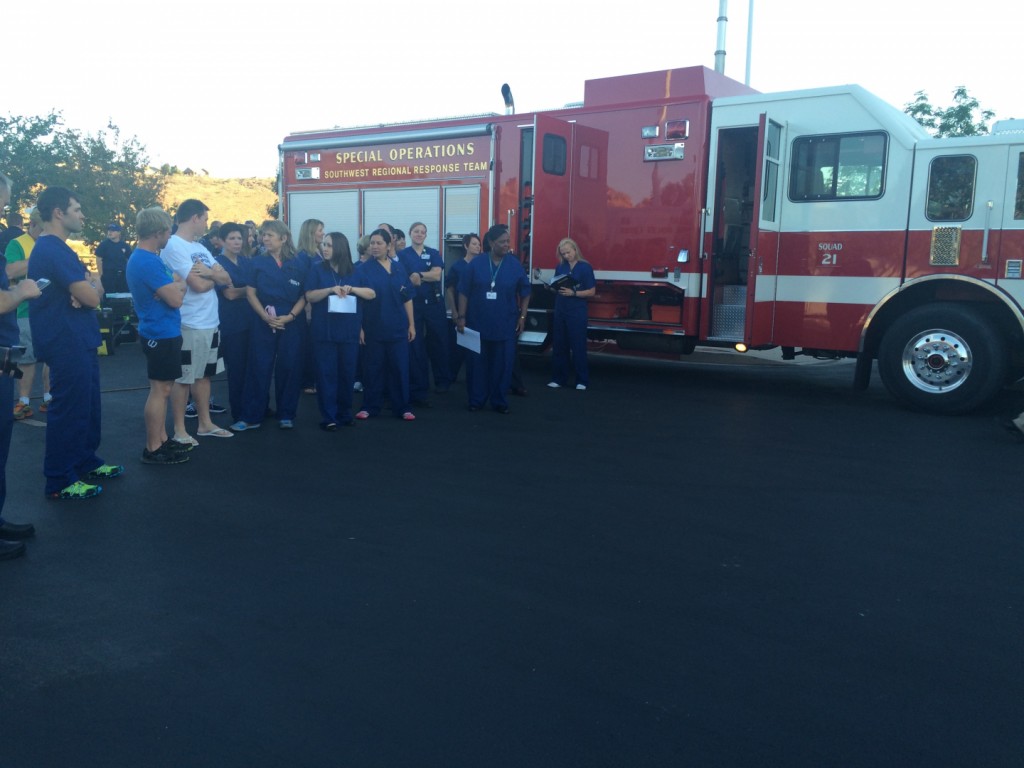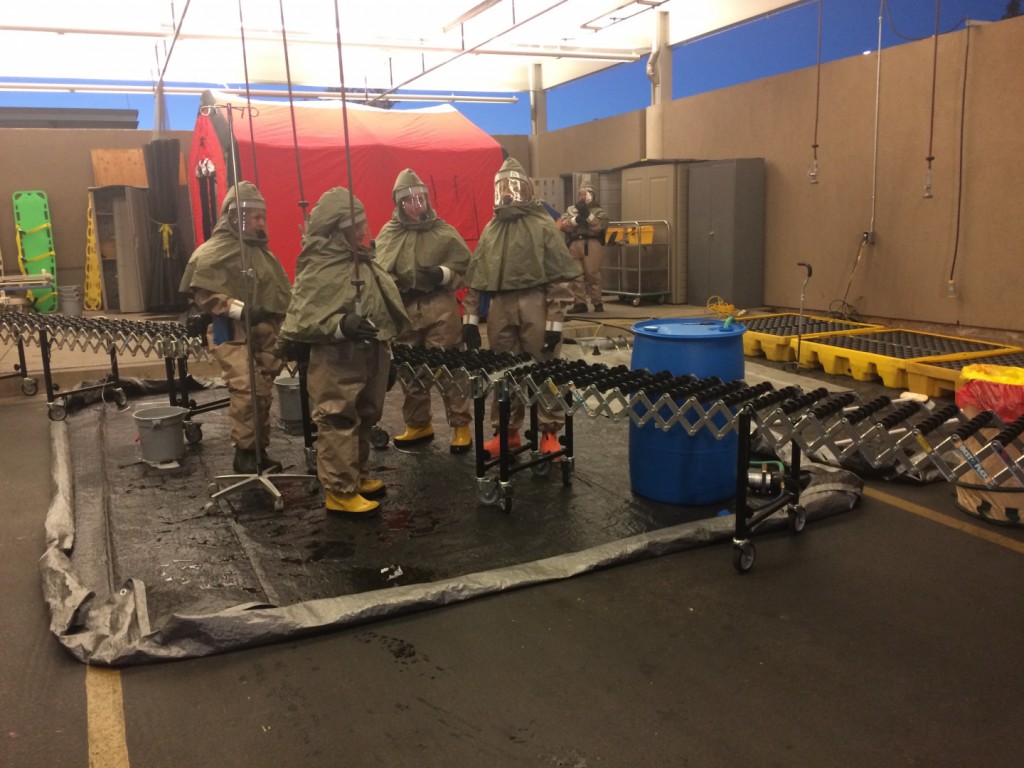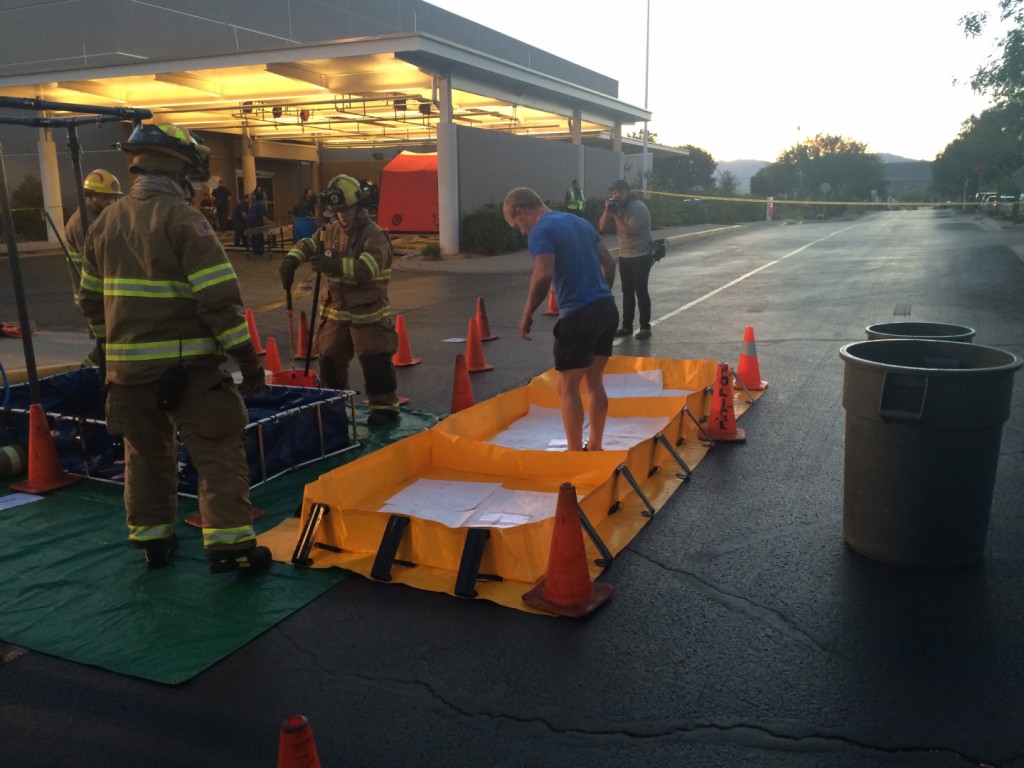
ST. GEORGE – The Southwest Regional Hazmat Team held a drill at Dixie Regional Medical Center in St. George Thursday night to practice responding to hazardous material spills and similar situations.
The process involved several different agencies, all working hand in hand to contain hazmat spills and help any patients who may have come in contact with the spilled materials. The St. George Fire, Colorado City/Hildale and Santa Clara fire departments, Gold Cross Ambulance, and nurses from Dixie Regional Medical Center all participated in the activity.
“Any hazardous materials that are transported have three ways that we can identify them” St. George Fire Department Capt. Jeff Tischner said. “There’s a placard that has the number on the outside of the container that we can look up so we can set up our hot zone, the radius where we need to keep people away and contain the materials. They also should have some shipping papers where we can identify the materials, and the third is the actual material itself. Whether it’s a solid, a liquid, or a gas, we have to know what the materials are so we can respond appropriately. In this scenario, the placard and shipping papers are incorrect, so we must identify the material itself.”
The drill started with two hazmat agents tending to two patients who had been exposed to the “chemical,” a mix of cornmeal and flour that simulated sodium peroxide, a caustic agent.
Once the hazmat agents tended to the patients, they were able to gather a sample and work with the science team to learn what the material was.
The next step in the drill was cleaning the hazardous agent off of the victims and hazmat agents if they had any material on them. Showing the facility where the cleaning process is performed, St. George Fire Department Battalion Chief Ken Guard said:
This is the “decon corridor,” where we clean the materials off of the patients. We set this up before anyone makes an entry down into the hazardous area down range (where the accident occurs); that way if anything goes wrong we can clean them off, and that’s basically all you’re trying to do is clean the contaminant off before we send them to a billion-dollar facility like the hospital or put them in a $100,000 ambulance.
“Drills like this really help us and practice and get better at what we do. It really helps the different agencies coordinate and understand the different roles that each agency has to play, so that the handoffs are seamless from one agency to another,” Intermountain Healthcare Communications Director Terri Draper said, speaking for the hospital. “The relationships are so key in the time of crisis because you’re already past the step of meeting people and learning their job, we’ve already done that. If a real scenario happens, you can connect well and do the handoff smoothly and hopefully have the best outcome possible.”
The hospital conducts several drills a year to help prepare for emergency situations. This past summer, they conducted a drill where they treated several gunshot victims.
Read and see more: DRMC, DSU hold mock mass-shooting exercise; STGnews Videocast and Photo Gallery
Click on photo to enlarge it, then use your left-right arrow keys to cycle through the gallery.

Nurses and fire crews prepare for the drill. Dixie Regional Medical Center, St. George, Utah, Oct. 16, 2014 | Photo by Brett Brostrom, St. George News

Simulated non-ambulatory patient being treated for spill.Dixie Regional Medical Center, St. George, Utah, Oct. 16, 2014 | Photo by Brett Brostrom, St. George News

The hospital nurses and decon corridor, where ambulatory and nonambulatory patients are treated for hazmat spills before being admitted to the hospital. Dixie Regional Medical Center, St. George, Utah, Oct. 16, 2014 | Photo by Brett Brostrom, St. George News

Simulated hazmat spill. Dixie Regional Medical Center, St. George, Utah, Oct. 16, 2014 | Photo by Brett Brostrom, St. George News

Hazmat technicians prepare spill victim to be transported to the hospitals decon corridor, where any hazardous materials will be cleaned off of his body. Dixie Regional Medical Center, St. George, Utah, Oct. 16, 2014 | Photo by Brett Brostrom, St. George News

Pretend patient enters into the decon corridor to have any hazardous materials cleaned off his body. Dixie Regional Medical Center, St. George, Utah, Oct. 16, 2014 | Photo by Brett Brostrom, St. George News

Nurses from Dixie Regional Medical Center put on their hazmat suites. Dixie Regional Medical Center, St. George, Utah, Oct. 16, 2014 | Photo by Brett Brostrom, St. George News
Related Stories
- Hurricane City drills for disaster; STGnews Videocast
- It’s not a terrorist attack, just a weeklong special services drill
- City considers 5 county hazmat co-op, Thunderbird Gardens trail system, Broadband franchise
Email: [email protected]
Twitter: @STGnews
Copyright St. George News, SaintGeorgeUtah.com LLC, 2014, all rights reserved.